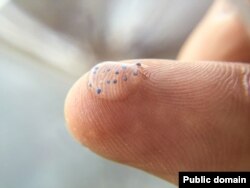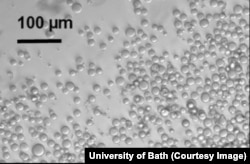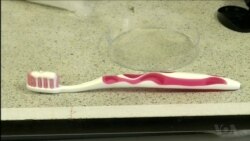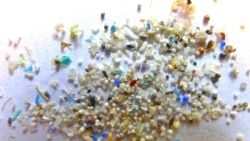Microbeads are tiny pieces of plastic used in many products to help clean skin or teeth. They are a kind of microplastic, which are pieces of plastic less than 5 millimeters in size.
They are found in many kinds of exfoliants. In skin and beauty products, the microbeads help to remove dead skin cells and make skin smoother.
But these very small pieces of plastic go right into the ocean.
Janet Scott is a chemist and researcher at England’s University of Bath.
"If you were washing yourself once a day with the microbead containing formulation to give you that nice smooth glow that you get when you use an abrasive formulation, you would be putting something like 80 to 100,000 microbeads down the drain every time you did that..."
After going down the drain, those thousands of plastic microbeads go into the ocean. They are too small to be captured in waste water treatment plants. They then become part of the more than 8 million tons of plastic that end up in the oceans every year.
The microbeads may absorb, or take on, poisons in the water. This hurts fish that eat the plastic, thinking it is food. Those fish may later end up being in a human’s meal.
The U.S. Environmental Protection Agency reports that oceans are not the only waters affected. The Great Lakes, rivers and estuaries also contain microbeads and other microplastics.
In 2015, the United States banned the use of plastic microbeads in products like soap and toothpaste. Several other countries -- mostly in Europe -- have also called for banning their use.
Now, British researchers are using cellulose to create microbeads.
Cellulose is a substance found in plants. It is biodegradable. Unlike plastic, it will naturally break down — or degrade -- over time.
Janet Scott explains.
"Because of the ways cellulose degrades, it should degrade in the waste water treatment plant. It shouldn't even make it into the oceans..."
Researchers make the microbeads by pushing the cellulose through a very small steel membrane.
Davide Mattia, a chemical engineer with the University of Bath, describes just how small the membrane is.
"With this project, we use a relatively small membrane. This is about one centimeter in diameter, roughly 10 centimeters of active area. This membrane itself contains millions of pores, meaning we're making millions of droplets, millions of microbeads..."
While that may sound like a lot of microbeads, it is not nearly enough to meet the demand. The team is working to increase production.
Mattia explains.
"This is too small for an industrial-scale process, and there are two ways to make more beads. One: use a bigger membrane, so this is double the length, so you're making double the amount of product. Or you can also have more than one membrane, and so that's called numbering up. So the more membranes you have the more products you have..."
The researchers are working with a British firm called Micropore Technologies. They will help take the production of cellulose microbeads to an industrial level.
Other natural products are also being used in place of plastic. They include the pit, or center, of apricot fruits and the shells of nuts.
The pits and shells are ground up and are rough enough to be exfoliants. They – along with jojoba beads – have been used for years by cosmetics manufacturers.
So has pumice – a lightweight stone formed by volcanic activity. It has long been used in many kinds of exfoliating and cleaning products.
I’m Anne Ball.
Kevin Enochs wrote this story for VOA News. Anne Ball adapted this story for Learning English. Ashley Thompson was the editor. We want to hear from you. Write to us in the Comments Section and visit us on our Facebook page.
_____________________________________________________________
Now, test your understanding with this short quiz.
_______________________________________________________________
Words in This Story
exfoliant – n. a mechanical or chemical agent to remove dead cells from the skin’s surface
glow – v. to have a warm reddish color from exercise or emotion, to look happy and healthy
abrasive – adj. having a rough quality or used for rubbing something to make it smooth
absorb – v. to take something in
estuary – n. an area where a river flows into the sea
biodegradable – adj. capable of being slowly destroyed and broken down into very small parts by natural processes, bacteria, etc.
membrane – n. a thin sheet or layer
pore – n. a very small opening on the surface of something
industrial scale – adj. a large size for commercial use













